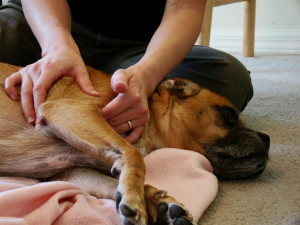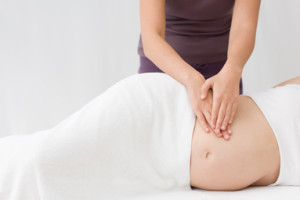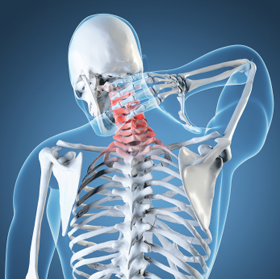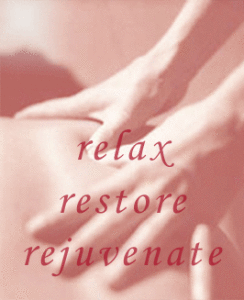Animal Massage: The Touch That Heals
 Animal massage can benefit both you and your pet in many ways. It is a wonderful way to connect with them at many different levels and to share quality time together. It can be done while listening to music, sitting in your favorite chair or couch, laying down in front of the fireplace on a cold autumn day, or while watching T.V.. There are a number of massage techniques depending upon what your goal is. You can use massage just to help your pet relax or to bond with them, to enjoy the magic of touch or it can be beneficial therapeutically in certain conditions. If you notice, pets stretch on their own to relax and keep in shape. Certain yoga postures are actually named after animal stretches such as the dog stretch and the cat stretch! However, as animals get older and stiff, they can’t stretch and move around as easily. There are many natural approaches to help this including nutritional supplements, acupuncture as well as massage.
Animal massage can benefit both you and your pet in many ways. It is a wonderful way to connect with them at many different levels and to share quality time together. It can be done while listening to music, sitting in your favorite chair or couch, laying down in front of the fireplace on a cold autumn day, or while watching T.V.. There are a number of massage techniques depending upon what your goal is. You can use massage just to help your pet relax or to bond with them, to enjoy the magic of touch or it can be beneficial therapeutically in certain conditions. If you notice, pets stretch on their own to relax and keep in shape. Certain yoga postures are actually named after animal stretches such as the dog stretch and the cat stretch! However, as animals get older and stiff, they can’t stretch and move around as easily. There are many natural approaches to help this including nutritional supplements, acupuncture as well as massage.
Let’s review some basic massage as prevention and then we will go over some specific acupressure that you can do on your pet for specific conditions such as hip dysplasia or arthritis. Find a nice relaxing quiet place when your furry friend is not all wound up and ready to play and run wild. Sit or lay down with them and gently start brushing your hands over them from above their eyes, over their head, over their back and down to their tail. You do want to be cautious and not place your hand over an animals head that may be having behavioral problems and be dominant over you or other family members. If you have a problem like that, you should talk to an experienced animal trainer that uses humane positive reinforcement techniques to resolve such behavior problems or speak to your veterinarian if they have experience in behavior problems and training.
Otherwise, if one doesn’t have a pet with a dominance order problem, dogs and cats usually love to have their heads gently touched and brushed. When you follow the direction going forward to rear over the head, neck and back, you are actually following the acupuncture meridians. The most important thing to remember when massaging or just petting your friend is to watch their reactions and listen to them. They let you know in many ways if they are enjoying you touching them or not. If they don’t like you touching a certain area regularly, check it out and make sure there isn’t a problem there. This is actually an excellent way to conduct a superficial physical exam. For instance, if your cat was in a cat fight and has an abscess on its back under the fur and you go over it and they go to scratch you or hiss or bite, stop immediately! You may have just picked something up that you may not have observed otherwise until they got much sicker.
So regular massage and petting can actually be a preventive measure where you may observe things much earlier. Another example is if while you are petting your dog and you feel excess heat over an area of their back, it may be an early sign of a “slipped disc” or arthritis in an area. So even, the most basic petting and gentle massage over the back can bring your attention to something important. If you find that your buddy actually rubs into you instead of away from you and kind of moans and groans in ecstasy, that is an area you may want to massage deeper or for a longer period of time.
Acupressure points on the body are usually small depressions between muscles or between muscles and bones. You may apply steady rotating pressure with a fingertip to a particular acupressure point. If you want to relax the point, gently massage counterclockwise over the point. If you want to stimulate it and give more energy, rub clockwise. If your pet is generally lethargic and weak, clockwise movement will often perk them up. If they tend to be nervous or hyperactive or sore in an area, counterclockwise movement will usually calm them down and relax the sore muscles. This has not been proven by double blind studies by any means, but in chinese acupressure, this is what is recommended.
While massaging your pet, breathe deeply, slowly and regularly and it will relax both of you and create your own rhythm. For if you are hyper and irritable and try to massage your pet, they seem to pick up on that and it can make them irritable and not want to be around you. So it truly is a wonderful way to slow down and relax for yourself. For prevention and enjoyment, you can massage your pet daily or as often as possible.
Again, it relaxes both of you and offers innumerable benefits that way. Therapeutically, acupressure massage can help if your pet has arthritis in a particular joint, if they have a stiff neck or back and even if they have certain internal medical problems. The positive effect of touching and massage can stimulate different neurotransmitters such as endorphins, making them feel better and thereby stimulate the bodies own healing mechanisms.
An example of massage helping a pet is in a case of an old dog with arthritis in their hip. There are three acupressure points around the hip joint. One point is just in front of the hip joint, one above it and one behind it. If you gently massage those points with one or two fingers in a counterclockwise rotation, they often times just relax and groan in ecstasy! There are also points on each side of their spine in small depressions one to two finger widths on each side of the backbone. These can also be massaged. When a dog has arthritis, it is not uncommon for them to hunch their back to compensate and they their back hurts. If they have arthritis in an elbow on the front leg, you can gently massage around the joint as well as the muscle masses around the shoulder and the neck. Again, feel for small depressions and gently rub those and see their response.
Listen to your pet! If they don’t like it, resist, growl, hiss or worse, stop immediately. Most pets usually love it though. There are times when you do not want to massage your pet. Avoid massage after your pet has just eaten. You should wait at least two hours after eating. If your pet is sick with an infection, a fever or a serious disease, they may not want to be touched; again, listen to them.
Avoid massaging the back and belly of a pregnant animal. You could possibly, unintentionally induce premature labor. You also do not want to massage your pet after they have just been exercising intensely. First let the heart rate come down to normal and stop panting before massaging. Later that day, I am sure they would love some massage, just like you or I would. After performing a general full body massage and focusing on any specific areas that need more attention, you can finish off the massage or begin one with slow, gentle rubbing of the inside and outside of each ear. This will provoke wonderful sighs of contentment in your dog and exquisite purrs in your kitty.
For further descriptions of pet massage with pictures, you can check out Dr. Michael Fox’s book “The Healing Touch” as well as a chapter in my book “Love, Miracles and Animal Healing”. You and your pet can both mutually benefit from massaging them and sharing quality time and loving each other. Give and ye shall receive! Enjoy the magic of touch till next time!
No article can replace the services of a trained veterinarian. This article is not intended to encourage treatment of illness, disease, or other medical problems by the layman. Any application of the recommendations set forth in this article is solely at the reader’s discretion and risk. You should consult a veterinarian concerning any veterinary medical or surgical problem. If a veterinarian is caring for your pet, for any condition, he or she can advise you about information described in this article.
If you or anyone you know has a pet that suffers from chronic pain and would like your pet to attain a better quality of life, those in the Inland Empire region, please contact me today to book a session.








 Research released in July 2011 expanded on previous studies demonstrating the effectiveness of massage therapy for chronic low back pain. Researchers found that “patients receiving massage were twice as likely as those receiving usual care to report significant improvements in both their pain and function”. The study was conducted over 10 weeks through Group Health Research Institute.
Research released in July 2011 expanded on previous studies demonstrating the effectiveness of massage therapy for chronic low back pain. Researchers found that “patients receiving massage were twice as likely as those receiving usual care to report significant improvements in both their pain and function”. The study was conducted over 10 weeks through Group Health Research Institute.